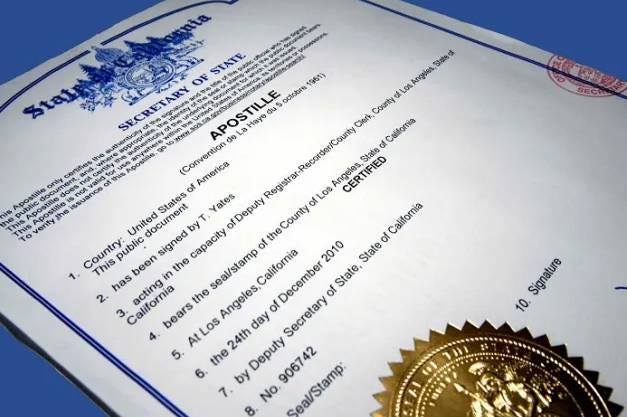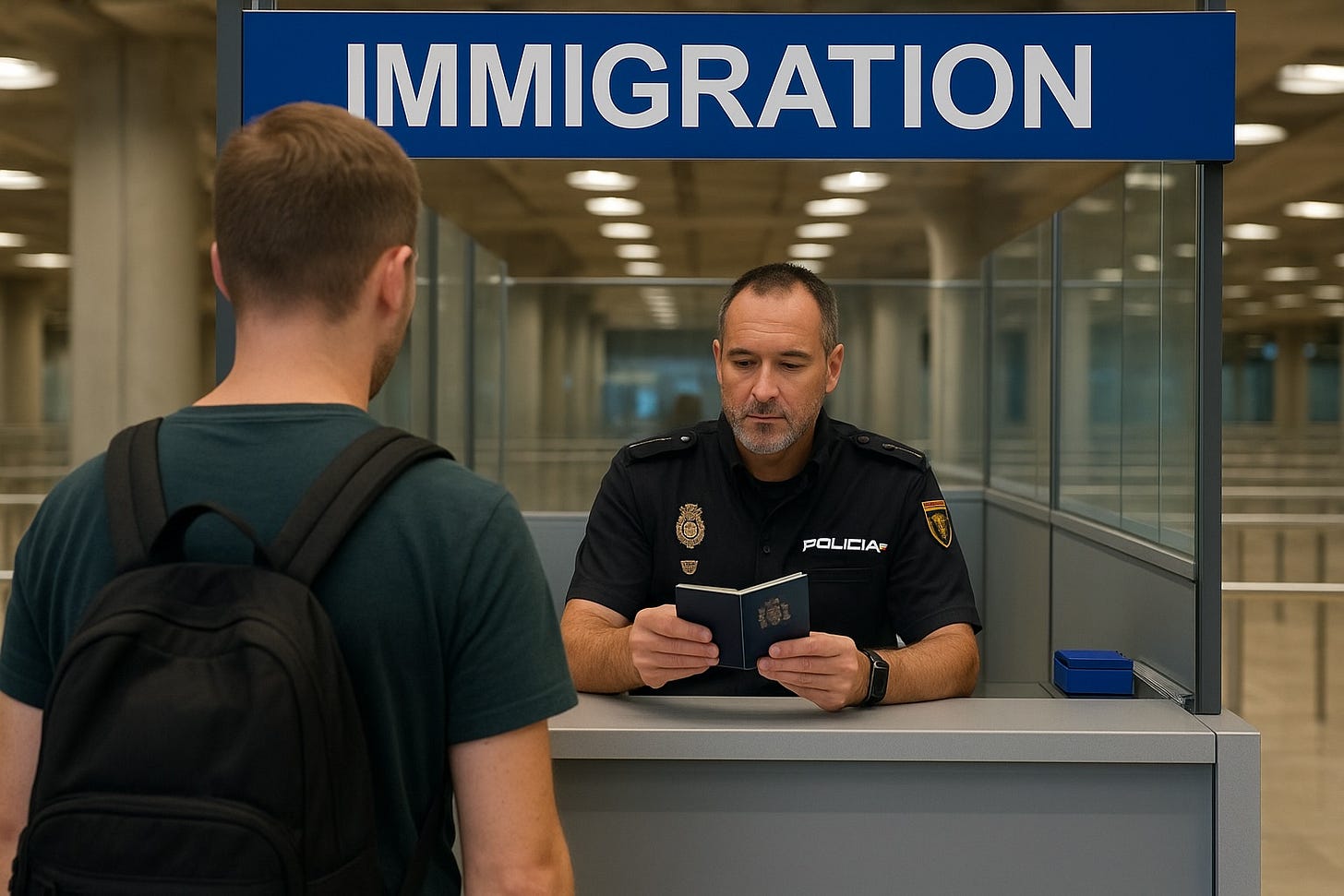🛂 How to Get a Spanish Non-Lucrative Visa
From gathering paperworks to fighting the bureaucracy jungle.
Madrid | Sept. 23, 2025
🇪🇸 The Bubble is Spain's #1 English-language, bestselling newsletter. We offer paid subscriptions, and we’d be thrilled to have your support!
🚨 This is one of The Bubble’s expanded feature articles and guides for subscribers. We’d love to hear from you about this piece via a “like” or comment. Enjoy!
So You Want to Live in Spain?
So, you’ve fallen in love with Spain — the tapas, the culture, the ¡hola, hola, hola!, the bureaucracy (fine, not the bureaucracy yet — see video below — but in time you will) — and now you want to stay longer than a tourist. For non-EU citizens (yes, Americans, we’re looking at you), the Non-Lucrative Visa (Visa No Lucrativa) is your golden ticket to live in Spain without working. Think of it as Spain saying: “Sure, come drop your money here, just don’t take a Spanish job!” Put simply, this visa lets you reside in España as long as you have the cash, paperwork, and patience to get through a bit of Spanish bureaucracy. In this guide, we’ll walk you through each step with The Bubble’s playful tone (because we know you’re probably nervous and need a laugh).
What’s the Non-Lucrative Visa (NLV)? It’s a residence visa for non-EU nationals who won’t be working in Spain. You must prove you have enough savings or passive income to support yourself (and any family you bring) — more on the exact numbers in a bit. You also need private health insurance, a clean background, and a willingness to fill out forms ad nauseam. Unlike Spain’s new Digital Nomad Visa (which allows remote work for foreigners) or the now-defunct Golden Visa (for big investors), the NLV is ideal if you’re essentially retiring, taking a sabbatical, or living off investments. It’s one of the most popular pathways for Americans, Brits, Canadians, Australians, and other non-EU folks to settle in Spain. Ready? ¡Vamos! — Let’s break down the process step by step.
The info here is accurate and up-to-date for 2025 at time of publication, but the joy of the internet means that we will update it as rules change (and they do, as our friend James Blick points out here). Please feel free to rub our noses in any mistakes you find by emailing us. Last changes to this guide were made on Sept. 22, 2025.
Also, we’d like to give special thanks to Cora LeCates for invaluable fact-checking and editing work as we were designing this guide over the summer.
Table of Contents

1. First Steps
⏱ Time: A few weeks to a few months (mostly time to research and prepare)
💶 Cost: Low ($0–$100 at this stage — main investment here is time and sanity)
✅ Quick Checklist
☐ Decide if the Non-Lucrative Visa (NLV) is right for you (no work allowed).
☐ Find your consulate (you must apply where you legally reside).
☐ Sketch a timeline backwards from your move date.
☐ Budget: $1,000–$2,000 (U.S.), £2,000–£2,500 (U.K.), others in between.
☐ Start Spanish classes (optional, but muy recomendable).
The first step is all about research and planning — but since you’re reading this, you’re off to a great start. Begin by confirming that the Non-Lucrative Visa is indeed the right visa for you. Remember, “non-lucrative” means no working for money while in Spain. You can’t work for a Spanish company or even freelance for clients in Spain on this visa. If you secretly plan to work remotely for a U.S. company, note that the letter of the law forbids any work, though enforcement has been conspicuous by its absence (let’s just say we’ve met a few lots of people who exploit this grey area). To play by the rules, though, consider the new Digital Nomad Visa instead if you want to work remotely (it has different requirements, like a higher income threshold that is based on Spain’s minimum wage, but working on it is legal) — but for this guide, we’ll assume you truly intend not to work in Spain at all. Embrace your dream of leisurely menú del día life unbothered by work calls! 🥳
Learn the Basics: Visit the official website of the Spanish consulate that serves your area to read their requirements for the non-lucrative visa. Spanish consulates in different countries (and even different cities in the same country) often have slightly different instructions or checklists. For example, the Spanish Consulate in Los Angeles might phrase things differently than the one in New York or London. Find your consulate by searching “Spain Consulate [Your City or Country] non lucrative visa.” Most consulate websites have a page dedicated to this visa — read it thoroughly. The core requirements will be the same, but some consulates require extra forms or specific document formats.
Jurisdiction Matters: You typically must apply at the Spanish consulate in your home country (or country of legal residence), and each consulate has a jurisdiction. For instance, if you live in Texas, you’d apply via the Houston consulate; if you’re in California, it’s likely Los Angeles or San Francisco, etc. Britons must use the BLS International visa service centers in London, Manchester, or Edinburgh (since Brexit, the U.K. is third-country too, and Spain outsources visa processing there). Canadians have consulates in Toronto, Montreal, and Ottawa. Australians usually apply at the Consulate-Generals of Spain in Sydney, Melbourne and Canberra. Check which office covers your state or province — showing up at the wrong consulate is a faux pas that could waste weeks.
Rough Timeline Planning: At this first step, sketch out a timeline. Work backwards from when you hope to move to Spain. A realistic plan might look like: “I want to be in Spain by October 2026. That means I should submit my visa application by, say, July 2026 (since it can take up to 3 months to get approved). That means I need all my documents ready by June.” Many documents (like background checks and medical certificates) must be issued within 90 days of your application, so you can’t get them too far in advance. However, some prep work can (and should) be done early — for example, gathering financial statements or getting a head start on notarizations.
Budgeting & Professional Advice: Now is also the time to budget for the whole process. Spoiler: it’s not exactly cheap. You’ll have fees for visas, translations, notarizations, apostilles, travel to the consulate, and so on. A rough ballpark: Americans often spend $1,000–$2,000 in total for the visa process, including everything (fees, insurance, document procurement, etc.); Brits might spend £2,000–£2,500 (their visa fees are higher, and the cost of private health insurance can be a bit more), Canadians somewhere in between. We’ll detail these as we go. If this is starting to sound overwhelming, you might consider hiring an immigration lawyer or consultant — they charge a hefty sum, but some people find the hand-holding worth it. For a DIY approach (which is doable, many have succeeded on their own), our guide has you covered.
Set the Right Expectations: Get into the Spanish mañana mindset early. The process can take a while — Spanish bureaucracy moves at its own pace (though it has gotten better). Legally, visa decisions can take up to 3 months for non-lucrative visas. In practice, some consulates respond in 4-6 weeks, but be mentally prepared for the full wait. Don’t quit your job, sell your house, or buy a one-way ticket just yet. Instead, use this planning period to also start learning a bit of Spanish if you don’t speak it already.
On a lighter note, start imagining where in Spain you want to live. The visa isn’t tied to a location, so you could stay in sunny Málaga or the Barcelona of Gaudí or wherever you fancy (just remember to register locally once there). Motivation is key: know why you want to move, and keep that dream in mind during the tedious bits. Need inspiration or an overview from someone who knows how it’s done? Check out friend-of-Bubble James Blick’s “ULTIMATE Move to Spain Guide 2025” or this immigration lawyer’s “Everything You Need to Know About Spain’s Non-Lucrative Visa” for a 10-question rundown. They are great primers that will make the process feel more real (and answer common questions you didn’t even know you had).
Armed with knowledge and a dash of humor, you’re now ready for the paper chase to begin!

2. Gathering the Required Documents
⏱ Time: 1–3 months
💶 Cost: $200–$500 (fees, apostilles, translations, photos, copies)
✅ Quick Checklist
☐ Application forms: National Visa + EX-01
☐ Passport: valid +1 year, 2+ blank pages, copies
☐ Passport photos: 2x, white background, Schengen standard
☐ Background check: FBI/ACRO/RCMP/AFP → Apostille → Spanish translation
☐ Medical certificate: doctor’s letter → Apostille → Spanish translation
☐ Proof of residence in consular jurisdiction: ID or utility bill
☐ Family docs (if applicable): marriage/birth certificates → Apostille → translation
☐ Miscellaneous: flight or accommodation booking (optional but helpful)
☐ Copies, copies, copies: at least 1 set of everything, preferably 2
Now the fun begins — assembling your dossier of paperwork. The NLV application requires a stack of documents that, by the end, will make you feel like an undercover agent with a top-secret file (or just a bureaucrat from Terry Gilliam’s Brazil). Let’s break down the checklist of documents you’ll need to gather (for you and each family member coming with you, unless stated otherwise):
Application Forms: We’ll cover filling these in detail later, but note that you’ll need a National Visa Application form (usually a 4-page form similar to a Schengen visa form, but for national visas) and a Spanish residency application form called EX-01 (Formulario de solicitud de autorización de residencia no lucrativa). Print these out or pick them up and put them in your visa file.
Passport: Your passport must be original (i.e., not a copy), valid for at least 1 year beyond the visa, and have at least 2 blank pages. If it’s due to expire — renew it now! You’ll also need photocopies of the ID page. Pro tip: make 2-3 copies; one will go with your application, and it’s good to have spares.
Passport Photos: Typically, 2 passport-size photos with a white background. Get a few taken (they’re cheap) because different forms might each need a photo glued on. Make sure they meet Schengen standards (no smiling, neutral expression — just channel your inner DMV).
Proof of Financial Means: We’ll detail this in Section 3. Note: If you’re of working age but planning not to work, some consulates (like Los Angeles) ask for an affidavit or letter stating you won’t work — for example, a letter from your last employer confirming you left, or a notarized personal statement that you will not seek employment in Spain. Check your consulate’s website to see if this is required.
Private Health Insurance: We’ll cover this in Section 4.
Background Check (Police Clearance Certificate): All adult applicants must provide an official criminal record check from their country (and any country they’ve resided in during the last 5 years). For Americans, this means an FBI Background Check (we found this YouTube video very helpful — both for the content and for the immigration lawyer’s home decor); for Brits, an ACRO Police Certificate; for Canadians, an RCMP criminal record check; for Australians, an Australian Federal Police (AFP) check, etc. Getting this can take time. For example, in the U.S., you’ll need to submit fingerprints to the FBI (either via an approved FBI channeler for faster service or directly to the FBI, which can take a few weeks). Brits apply to ACRO online, and it usually takes a couple of weeks. Important: The background check must then be legalized with an Apostille (see below) and translated into Spanish. Also, these certificates typically expire after 3 or 6 months (consulates usually require the check be issued within 90 days of your visa appointment), so time it right. We’ll explain apostilles and translations shortly 👇.
Medical Certificate: A doctor’s letter stating you’re free of any diseases that could pose a public health risk, per the 2005 International Health Regulations. In plain terms, that’s a letter from your physician on letterhead saying you don’t have things like polio, tuberculosis, yellow fever, Ebola, black plague — all the fun stuff. Most consulates even provide specific wording. For example, they often want a line like: “This patient does not suffer from any illness that would pose a threat to public health according to the International Health Regulations of 2005.” You can get this from your GP or a travel clinic. Make sure it’s signed by an M.D. and notarized (if required by consulate). Then, guess what — it also needs an Apostille and a Spanish translation, since it’s a foreign document. Keep the original and get a copy. (Honestly, we’ll discuss Apostilles in a moment — hang tight 🙀!)
Proof of Residence (Consular Jurisdiction): This one is often overlooked until someone gets asked for it at the appointment. You need to prove that you live within the territory of the consulate you’re applying to. Usually, a driver’s license or state ID with your address, or a recent utility bill or voter registration card suffices. Americans, this means bring your driver’s license (original and a copy) that shows your home address. Brits might use a recent bank statement or utility bill with their U.K. address. Have this ready so your consulate doesn’t question your eligibility to apply there.
Miscellaneous Documents: Some consulates in the past have asked for an itinerary or reservation for your travel to Spain (you’re not required to have a flight before approval of your NLV— but check your consulate’s instructions). Others might ask for proof of accommodation in Spain (again, not usually, but some applicants include a rental agreement, hotel booking, or a letter from a friend/family where you’ll stay). If you do have a rental contract or property deed in Spain, definitely include a copy; it can strengthen your application by showing you have a landing spot. If you don’t have one yet, don’t panic — it’s usually not mandatory.
Family Documents: If you are applying with family (spouse, kids), you’ll need a marriage certificate and birth certificates for your kids to prove the relationship. Those documents, if issued outside Spain, will also need to be Apostilled/legalized and translated. For example, an American bringing a spouse will include an Apostilled marriage certificate with translation. Ensure you also get separate application forms and duplicates of every required doc for each family member. (Yes, that means if you have a family of four, you’ll be swimming in a paperwork pool — start a filing system now!)
Copies, Copies, Copies: Assume that for every original document, the consulate wants a photocopy (watch the video that starts this guide — twice). The general rule: have one copy of everything for their files (and keep your originals). Some consulates even want two copies of certain things. There’s nothing worse than being at the appointment and hearing, “We need a copy of X,” and realizing you don’t have it. Pro tip: Organize your documents in the order listed on the consulate’s checklist, and use labeled folders or clips for each section (e.g., “Forms”, “Passport”, “Financials”, etc.). It makes you look like the type-A applicant of their dreams and speeds up the review.

Apostilles & Legalizations: Many of the documents above — notably your background check, medical certificate, and any civil documents (marriage/birth certificates) — need to be authenticated for international use. Since Spain is a member of the Hague Apostille Convention, the way to do this is by obtaining an Apostille for each document. An apostille is basically a fancy certificate attached to your document by the competent authority in the country of origin, verifying that the notary or official who signed your document is legit. Think of it as an internationally-recognized notarial super-seal. 💪
For the U.S., a state-issued document (like a notarized medical letter or state police check) gets an apostille from that state’s Secretary of State (here’s Pennsylvania’s version), whereas a federal document (like an FBI report) gets an apostille from the U.S. Department of State in Washington, D.C. For the U.K., the Foreign, Commonwealth & Development Office (Legalisation Office) in Milton Keynes issues apostilles (now often just called “legalisation”) — you can apply online via GOV.UK and mail in your document, and they’ll send it back with a stamped apostille attached. Canada historically wasn’t part of the Apostille Convention and used a different “authentication and legalization” process (involving Global Affairs Canada and then the Spanish consulate), but good news: Canada joined the Apostille Convention effective Jan. 11, 2024, which greatly streamlines things. Canadians can now get an apostille from Global Affairs Canada for their documents, just like other countries do, instead of the old multi-step process. Australia has long been in the convention — Aussies get apostilles from the Department of Foreign Affairs and Trade (DFAT) offices.
In short, figure out who issues apostilles in your country (usually a government office), and plan to apostille each required document after you obtain the document itself. Apostilles often come with fees per document (e.g., around $20 per doc in the U.S., £35+ in the U.K., etc.), and processing times can range from same-day (if you walk into some offices) to several weeks (especially for the U.S. Department of State by mail, which can be slow). If you’re short on time, look into expedited services or couriers who can handle the apostille in person for a fee. Just make sure the apostille is securely attached (usually they staple it) — do not remove it, the whole thing becomes an official package.
Translation to Spanish: All foreign-language documents must be accompanied by an official Spanish translation. This typically means a translation done by a Sworn Translator (Traductor Jurado) certified in Spain, or a translator accredited by the consulate. Check your consulate’s rules: some will accept translations by any professional translator with a certification stamp, others insist on using translators from an official list. In the U.S., for example, consulates often accept translations done by ATA-certified translators or by certain agencies. In the U.K., you may need a Chartered Institute of Linguists or a sworn translator. The safest bet is to use a sworn translator in Spain — these are translators appointed by the Spanish Ministry of Foreign Affairs who can attach their stamp, and it’s universally accepted in Spain. Of course, hiring one means sending scans of your documents via email and paying their fee. Costs vary, but budget around $30–$50 per page for translation. A one-page document like a police cert or medical letter might be $40, multi-page bank statements could get pricey (good news: sometimes financial statements don’t need full translation — consulates often just want the summary translated or even accept them in English, especially if numbers are self-explanatory — again, check consulate guidance). Prioritize translating the critical letters: background check, medical certification, etc.
By the end of this document-gathering marathon, you should have: your Spanish visa forms, your passport and photos, the police record + apostille + translation, the medical letter + apostille + translation, copies of your ID and residency proof, and any miscellaneous extras (like cover letter, flight reservations, marriage certificate, birth certificates etc., if you need them). Take a moment to revel in this pile of papers — you’re basically starring in your own bureaucratic thriller.
Need a pep talk or a recap from someone who’s been through it? Try “What Documents do I need for my Spanish Non-Lucrative Visa? A step by step list” on YouTube. It’s a handy video that walks through the checklist to ensure you didn’t miss anything.
By gathering all your documents in advance, you’ll make the next steps much smoother. ¡Buen trabajo! Now, let’s talk money.

3. Proving Financial Means
⏱ Time: ~1 week (gathering docs)
💶 Cost: $10–$100 (bank letters, notarizations, translations)
✅ Quick Checklist
☐ Bank statements (3–6 months, plus end-of-year + average balance)
☐ Bank letter on letterhead (balances, notarized if possible)
☐ Pension / Social Security letters (with translations)
☐ Investment or brokerage account statements
☐ Rental income: leases + bank deposit proof
☐ Cover letter summarizing finances (in Spanish if possible)
☐ Tax return (if consulate requires it, e.g. Los Angeles)




